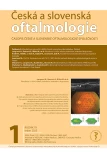USE OF A FEMTOSECOND LASER IN CATARACT SURGERY
Authors:
M. Králik 1; J. Halička 1,2; R. Vida 1; M. Gajdoš 1; M. Javorka 3; P. Žiak 1,2
Authors‘ workplace:
UVEA Mediklinik, Martin-Priekopa
1; Očná klinika, Jesseniova Lekárska fakulta v Martine, Univerzita, Komenského v Bratislave
2; Ústav fyziológie, Jesseniova lekárska fakulta v Martine, Univerzita, Komenského v Bratislave
3
Published in:
Čes. a slov. Oftal., 79, 2023, No. 1, p. 28-33
Category:
Original Article
doi:
https://doi.org/10.31348/2023/3
Overview
Aims: Cataracts continue to be the leading cause of blindness worldwide. Phacoemulsification is the gold standard in the treatment of cataracts. The aim of the study was to compare the postoperative results of the phacoemulsification technique in comparison with femtosecond laser-assisted cataract surgery (FLACS).
Material and Methods: Our work retrospectively evaluates the results of patients after implantation of an artificial intraocular lens for cataract from May 2017 to March 2019. The study evaluated a total of 80 implanted lenses in 47 patients operated on by two surgeons. Of the 47 patients, 28 were women. The mean age in the group at the time of surgery was 63.7 years, ranging from 34–79 years. Patients could choose FLACS (n = 45) surgery or standard phacoemulsification procedure (n = 35).
Results: Upon a comparison of the group regarding uncorrected distal visual acuity (UCDVA) up to 12 months after surgery, the group FAKO CATARACTS recorded 0.85 ±0.18 vs. 0.93 ±0.12 in the FEMTO CATARACTS group (p = 0.021), comparably uncorrected near visual acuity (UCNVA) was 0.77 ±0.18 vs. 0.84 ±0.17 (p = 0.034) respectively. A difference in the use of phacoemulsification energy (OZIL) was measured in patients with phacoemulsification 3.5 ±3.1 and in the use of femtosecond laser 2.2 ±3.1, (p = 0.005). In all cases, an AT LISA 839 trifocal lens (Carl Zeiss Meditec, Germany) was implanted.
Conclusion: The femtosecond platform assists the surgeon in cataract surgery with capsulorhexis and pre-fragmentation of the lens nucleus, which can be advantageous especially for complicated cataracts. We recorded significantly higher uncorrected distance and near visual acuity in the FLACS group, and also a significantly lower value of the phacoemulsification energy used.
Keywords:
cataract – femtosecond laser – photodisruption – femtosecond laser-assisted cataract surgery – capsulorhexis
Sources
1. Heissigerova J. Oftalmologie. Pro pregraduální i postgraduální přípravu. Praha: Maxdorf; 2018. Kapitola 8, Nemoci čočky; s.149-158.
2. Jelínková H. Lasers for medical applications Diagnostics, therapy and surgery. First published Cambrige: Woodhead publishing; 2013. Chapter 2, Laser characteristics; p.17-46.
3. Nagy ZZ, McAlinden C. Femtosecond laser cataract surgery. Eye Vis (Lond). 2015 Jun 30;2 : 11. doi: 10.1186/s40662-015-0021-7
4. Conrad-Hengerer I, Al Juburi M, Schultz T, Hengerer FH, Dick HB. Corneal endothelial cell loss and corneal thickness in conventional compared with femtosecond laser-assisted cataract surgery: threemonth follow-up. J Cataract Refract Surg. 2013 Sep;39(9):1307 - 1313. doi: 10.1016/j.jcrs.2013.05.033
5. Kránitz K, Miháltz K, Sándor GL, Takacs A, Knorz MC, Nagy ZZ. Intraocular lens tilt and decentration measured by Scheimpflug camera following manual or femtosecond laser-created continuous circular capsulotomy. J Refract Surg. 2012 Apr;28(4):259-63. doi: 10.3928/1081597X-20120309-01
6. Popovic M, Campos-Möller X, Schlenker MB, Ahmed II. Efficacy and Safety of Femtosecond Laser-Assisted Cataract Surgery Compared with Manual Cataract Surgery: A Meta-Analysis of 14 567 Eyes. Ophthalmology. 2016 Oct;123(10):2113-26. doi: 10.1016/j.ophtha.2016.07.005
7. Rozsíval P, Dusová J, Feurmannová, A. Trendy soudobé oftalmologie 9. svazek. První vydání. Praha: Galén; 2013. Femtosekundové lasery v oftalmologii (Jiří Pašta); s.76.
8. Krader CG. Laser cataract surgery making complex cases more routine (online). Ophtalmology Times; 2019. Available from: https:// www.ophthalmologytimes.com/view/laser-cataract-surgery-making - complex-cases-more-routine
9. Rodrigues R, Santos MSD, Silver RE, Campos M, Gomes RL. Corneal incision architecture: VICTUS femtosecond laser vs manual keratome. Clin Ophthalmol. 2019 Jan 10;13 : 147-152. doi: 10.2147/OPTH. S181144
10. Wang J, Su F, Wang Y, Chen Y, Chen Q, Li F. Intra and post-operative complications observed with femtosecond laser-assisted cataract surgery versus conventional phacoemulsification surgery: a systematic review and meta-analysis. BMC Ophthalmol. 2019 Aug 9;19(1):177. doi: 10.1186/s12886-019-1190-2
11. Kolb CM, Shajari M, Mathys L, Herrmann E, Petermann K, Mayer WJ, Priglinger S, Kohnen T. Comparison of femtosecond laser-assisted cataract surgery and conventional cataract surgery: a meta-analysis and systematic review. J Cataract Refract Surg. 2020 Aug;46(8):1075-1085. doi: 10.1097/j.jcrs. 0000000000000228
12. Chen L, Hu C, Lin X, Li HY, Du Y, Yao YH, Chen J. Clinical outcomes and complications between FLACS and conventional phacoemulsification cataract surgery: a PRISMA-compliant Meta-analysis of 25 randomized controlled trials. Int J Ophthalmol. 2021 Jul 18;14(7):1081-1091. doi: 10.18240/ijo.2021.07.18
Labels
OphthalmologyArticle was published in
Czech and Slovak Ophthalmology

2023 Issue 1
Most read in this issue
- RHEOPHERESIS IN THE TREATMENT OF AGE-RELATED MACULAR DEGENERATION
- RHEOPHERESIS AND ITS USE IN THE TREATMENT OF DISEASES WITH IMPAIRED MICROCIRCULATION. A REVIEW
- RHEOHEMAPHERESIS IN THE TREATMENT OF DRY FORM OF AMD. A CASE REPORT
- USE OF A FEMTOSECOND LASER IN CATARACT SURGERY
